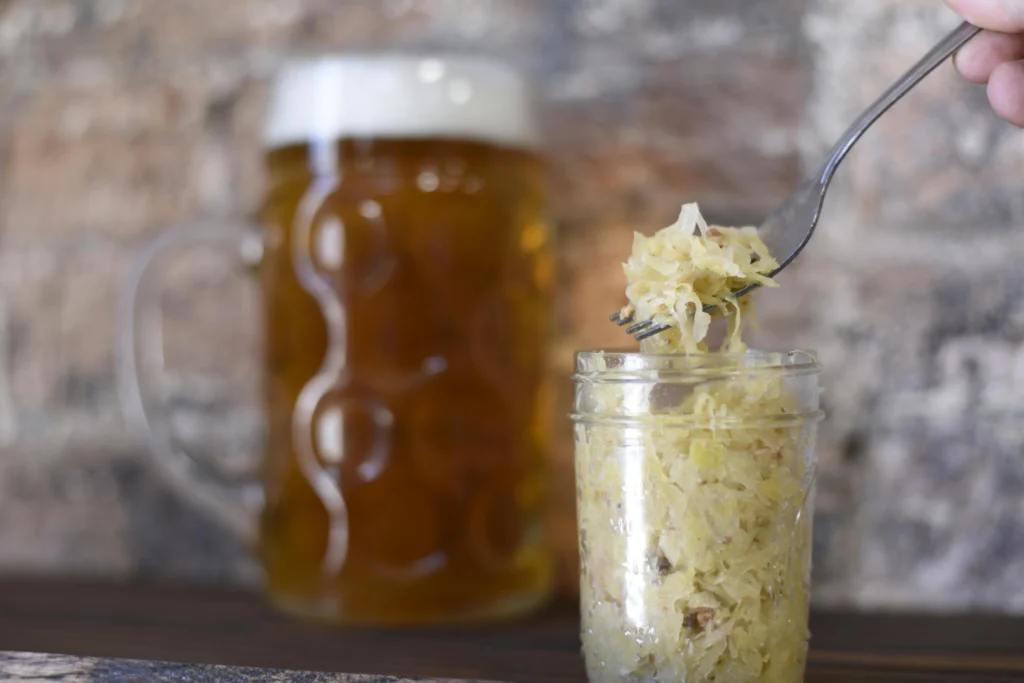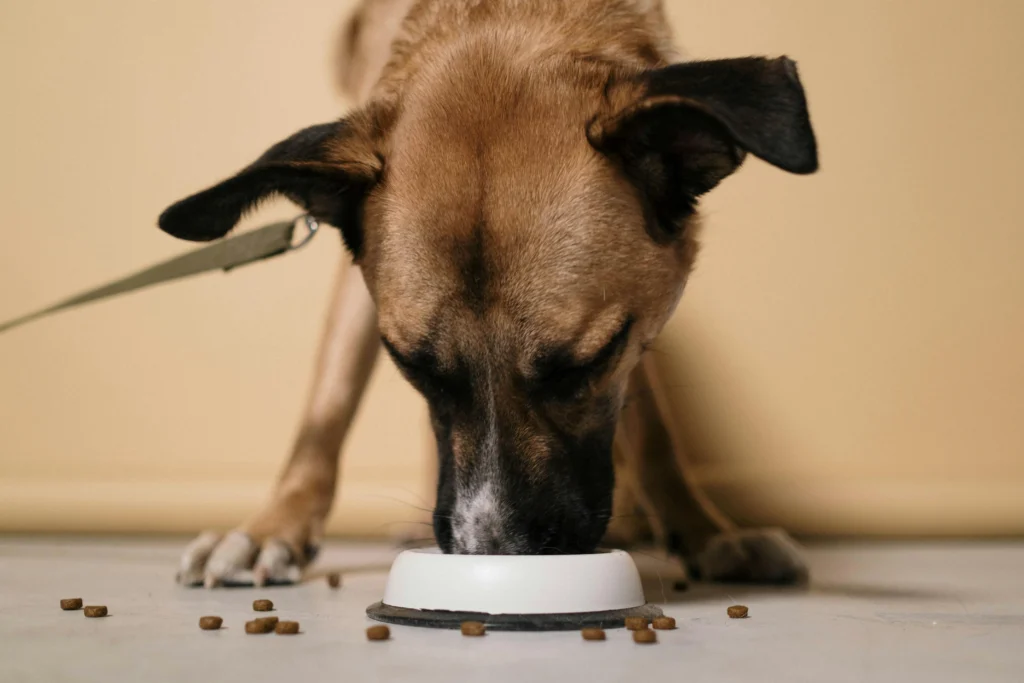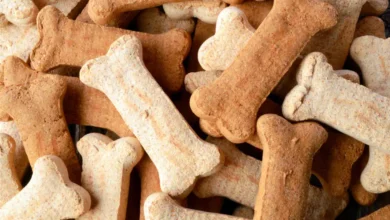Can Dogs Eat Sauerkraut?

You want the best for your four-legged companion – every treat, snack, and meal matters. As fermented foods like kimchi and kombucha gain popularity in human diets, you might wonder if tangy, probiotic-rich sauerkraut could also support your pet’s well-being. But before sharing that forkful from your plate, let’s explore what science and veterinarians say.
This crunchy fermented cabbage offers potential benefits due to its natural probiotics, which may aid digestion. However, not all varieties are created equal. Store-bought options often contain additives like garlic or excess salt, while homemade versions allow better control over ingredients.
Portion size plays a critical role – too much can upset sensitive stomachs. When introduced gradually and in moderation, this tangy food might become a gut-health booster for your pup. We’ll break down safe practices, compare preparation methods, and highlight red flags to watch for.
Understanding Sauerkraut and Its Nutritional Profile

What makes fermented cabbage a nutritional powerhouse? This tangy side dish starts as raw shredded leaves transformed through natural processes. Let’s unpack its components and how they develop.
Nutrient Breakdown: Vitamins, Minerals, and Probiotics
Finely chopped cabbage undergoes lacto-fermentation, where salt draws out moisture to create brine. Over weeks, beneficial bacteria convert sugars into lactic acid. This preserves the vegetable while boosting its nutrient density.
Key components include:
- Vitamin C: Supports immune function and collagen production
- Vitamin K: Aids blood clotting and bone health
- Iron and potassium: Essential for oxygen transport and muscle function
| Nutrient | Per 100g | Role |
|---|---|---|
| Vitamin C | 15mg | Antioxidant protection |
| Vitamin K | 13μg | Bone metabolism |
| Fiber | 2.9g | Digestive health |
| Probiotics | Varied CFUs* | Gut microbiome balance |
*Colony-forming units depend on fermentation time
The Fermentation Process and Its Benefits
This preservation method does more than extend shelf life. As microbes break down cabbage, they produce enzymes and bioactive compounds. These elements help maintain digestive harmony and nutrient absorption.
Raw fermented varieties retain live cultures that may:
- Support healthy gut flora
- Enhance mineral bioavailability
- Reduce inflammation markers
Portion Control Matters: Balancing Benefits and Risks
How much is too much when sharing human foods with pets? While fermented cabbage offers nutritional perks, its high sodium content demands careful measurement. Even beneficial additions require strategic planning in your companion’s meal plan.
Why Moderation is Key in Your Dog’s Diet
A teaspoon-sized portion serves as a safe starting point. Larger amounts risk overwhelming sensitive digestive systems with salt and acidity. Veterinarians note that gradual introduction helps identify tolerance levels without triggering issues like diarrhea or gas.
Consider these factors before serving:
- Existing health conditions affecting kidney function
- Age-related metabolic changes
- Current sodium intake from other foods
Identifying Safe Sauerkraut Options
Opt for homemade batches using only cabbage, water, and salt. Commercial varieties often contain hidden dangers like garlic powder or artificial preservatives. One study found store-bought brands contain 42% more sodium on average than DIY versions.
Always check labels for:
- Xylitol or onion derivatives
- Excessive vinegar content
- Unnatural coloring agents
When prepared correctly, this fermented food becomes a low-risk supplement. Pair tiny portions with regular meals to support gut health without disrupting nutritional balance.
Related Post: Are Milk Bones Bad For Dogs?
Homemade vs. Store-Bought Sauerkraut: Making the Best Choice for Your Dog
Choosing the right fermented cabbage for your pet involves more than grabbing the nearest jar. Preparation methods drastically affect nutritional value and safety. Let’s examine how DIY versions stack up against mass-produced options.
Benefits of Homemade Fermented Cabbage
Creating batches at home lets you skip unnecessary ingredients. Simple recipes require only shredded cabbage, filtered water, and minimal salt. This approach preserves live probiotics while avoiding harmful preservatives or spices.
Key advantages include:
- Adjustable sodium levels for sensitive stomachs
- No hidden toxins like garlic or onion powder
- Higher colony-forming units of beneficial bacteria
Risks of Commercial Additives
Many store-bought varieties undergo pasteurization, destroying heat-sensitive microbes. Vinegar-based brines halt fermentation, stripping away gut-friendly cultures. Some brands add sugar or artificial colors to enhance appearance and shelf life.
| Feature | Homemade | Store-Bought |
|---|---|---|
| Probiotic Activity | High | Low/None |
| Sodium per Serving | Controlled | Up to 42% Higher |
| Additives | None | Common |
Always scrutinize labels for xylitol or excessive salt. When uncertain, a small-batch homemade recipe offers safer health benefits without compromising quality.
Health Benefits of Sauerkraut for Your Dog
Fermented cabbage packs a punch of nutrients that may enhance your pet’s vitality. When prepared properly, this tangy superfood offers more than just digestive support—it could become a multi-functional addition to their meals.
Gut Health and Probiotic Advantages
The live cultures in unpasteurized sauerkraut act like tiny helpers for your pet’s stomach. These beneficial bacteria break down food particles, easing bloating and irregular bowel movements. Studies show regular probiotic intake may reduce constipation by up to 30% in animals with sensitive digestion.
Key gut benefits include:
- Balanced microbiome from diverse bacterial strains
- Improved nutrient absorption through enzyme production
- Reduced gas and stomach discomfort
Supporting Immune, Joint, and Heart Health
Antioxidants like vitamin C team up with probiotics to strengthen your companion’s defenses. One veterinary nutritionist notes: “Fermented foods create a protective barrier against pathogens while calming inflammatory responses.”
For senior pets, sauerkraut’s nutrients offer dual advantages:
- Glucosinolates support cartilage repair and joint mobility
- Fiber binds to excess cholesterol, promoting cardiovascular wellness
A teaspoon-sized serving delivers essential vitamins K and B6—critical for blood health and energy metabolism. Always pair these portions with balanced meals to maximize long-term health benefits without overwhelming their system.
Potential Risks and Harmful Ingredients in Sauerkraut
While fermented cabbage offers nutritional value, some store-bought versions hide dangers that could harm your pet. Many commercial products contain ingredients unsuitable for canine diets, turning a potential superfood into a risky addition.
Understanding Sodium Content and Toxic Additives
Premade varieties often pack excessive salt—a single tablespoon may contain 6% of a human’s daily limit. For smaller companions, this sodium overload strains kidneys and increases dehydration risks. One veterinary study found high-salt diets correlate with 18% higher blood pressure in older animals.
Beyond salt, watch for these hazardous additions:
- Garlic or onion powder (damages red blood cells)
- Caraway seeds (toxic to canines)
- Artificial preservatives like sodium benzoate
Always verify the source of ingredients before sharing. Look for labels stating “no added spices” or “100% cabbage.” Processed versions might include hidden sweeteners like xylitol—a substance 20 times more toxic to pets than chocolate.
When choosing food for your companion, prioritize plain homemade batches. Commercial products often use vinegar instead of natural fermentation, stripping probiotic benefits while introducing acidity that upsets sensitive stomachs. Remember: safe options contain only cabbage, water, and minimal salt.
How to Safely Introduce Sauerkraut into Your Dog’s Diet

Introducing new foods requires careful planning to support your pet’s wellness. Fermented cabbage can be a valuable addition when handled thoughtfully, but timing and preparation determine its effectiveness.
Steps for Gradual Introduction and Portion Control
Start with a pea-sized portion mixed into regular meals. This allows their system to adjust without overwhelming delicate digestion. Follow this three-step approach:
- Week 1: Offer ¼ teaspoon every other day
- Week 2: Increase to ½ teaspoon daily if no reactions occur
- Week 3+: Maintain 1 teaspoon maximum per 20 lbs body weight
Pair servings with probiotic-rich meals like plain yogurt to enhance healthy gut benefits. Always use raw, unpasteurized varieties—heat-treated versions lose 90% of their live cultures.
Raw vs. Cooked Sauerkraut: What Works Best
Unprocessed fermented cabbage retains its natural fiber and active microbes. Cooking destroys heat-sensitive probiotics while concentrating acidity, which may irritate sensitive stomachs.
| Feature | Raw | Cooked |
|---|---|---|
| Probiotics | Active | Inactive |
| Fiber Content | 3g/serving | 2.1g/serving |
| Digestibility | Moderate | Easier |
For pets with existing digestive concerns, raw options work best when introduced slowly. Observe stool consistency and energy levels—firm stools and normal activity signal a healthy gut adaptation.
If adverse reactions occur, pause feedings and consult your veterinarian. Remember: gradual changes protect your companion’s dog gut ecosystem while unlocking nutritional benefits.
Exploring Alternative Fermented Foods for a Robust Dog Diet

Diversifying your pet’s probiotic intake strengthens their digestive resilience. While fermented cabbage has its merits, other gut-friendly options offer unique advantages. Rotating these foods creates a balanced approach to supporting your companion’s microbiome.
Dairy-Based and Vegetable Probiotic Options
Plain yogurt and kefir stand out as digestive powerhouses. These dairy products contain live cultures like Lactobacillus acidophilus, which combat harmful bacteria. Always choose unsweetened varieties—added sugars disrupt gut balance and contribute to weight gain.
Key comparisons between popular fermented foods:
| Food | Probiotic Strains | Serving Size |
|---|---|---|
| Plain Yogurt | 2-4 active cultures | 1 tsp per 10 lbs |
| Kefir | 10+ microbial species | ½ tsp per 15 lbs |
| Fermented Carrots | Lactobacillus species | 1-2 shreds weekly |
Vegetable-based alternatives like fermented green beans or pumpkin provide fiber without dairy sensitivities. A veterinary nutritionist notes: “Rotating 2-3 probiotic sources prevents bacterial overgrowth from single-strain dominance.”
- Introduce new items at 3-day intervals to monitor reactions
- Avoid kombucha due to caffeine and alcohol content
- Opt for organic products to minimize pesticide exposure
Consult your veterinarian before expanding your pet’s menu. They can recommend specific strains based on age, breed, and health history for optimal digestive support.
Conclusion
Making informed choices about your pet’s nutrition ensures their long-term vitality. Fermented cabbage, when prepared without harmful additives, offers probiotic advantages that may enhance digestive harmony. Always prioritize minimal sodium levels and avoid spice-laden commercial products.
Introducing this tangy supplement requires gradual testing and strict portion control. Homemade batches provide live cultures that support nutrient absorption while reducing inflammation risks. Pair tiny servings with regular meals to maintain balance.
Explore diverse probiotic sources like plain yogurt or fermented vegetables for a well-rounded approach. These alternatives complement gut-friendly strategies while minimizing potential sensitivities. Remember: even beneficial foods demand careful evaluation of ingredients and preparation methods.
Consult your veterinarian before altering your companion’s diet. Their expertise helps tailor nutritional plans to individual health needs. By prioritizing safety and moderation, you empower your pet’s wellness journey through every bite.
FAQ
What makes sauerkraut a potential addition to a dog’s diet?
Fermented cabbage contains probiotics and fiber, which support digestive health. Its nutrients, like vitamin C and K, also promote immune function. Always introduce it slowly to avoid upsetting your pet’s stomach.
Are there risks linked to feeding store-bought varieties?
Commercial options often contain high sodium levels or additives like garlic and onions, which are toxic. Opt for organic, unpasteurized brands like Farmhouse Culture or Bubbies, and rinse excess salt before serving.
How much fermented cabbage is safe for pets?
Start with ¼ teaspoon per 20 pounds of body weight, gradually increasing to 1 teaspoon. Overfeeding may cause bloating or diarrhea due to its active bacteria content. Monitor reactions closely.
Can probiotics in fermented foods improve a dog’s gut health?
Yes! Beneficial bacteria balance the microbiome, aiding digestion and nutrient absorption. This strengthens the immune system and may reduce allergies or chronic conditions like arthritis.
Is homemade sauerkraut better than store versions for dogs?
Homemade recipes let you control ingredients, avoiding harmful additives. Use minimal salt and skip spices. Fermenting cabbage for 2–4 weeks ensures live cultures without preservatives.
What alternatives offer similar benefits?
Plain kefir, unsweetened yogurt, or fermented pumpkin provide probiotics. Brands like The Honest Kitchen offer freeze-dried options with digestive enzymes for sensitive stomachs.
Should you cook sauerkraut before serving it to pets?
Raw retains more probiotics, but lightly steaming reduces acidity if your dog has a sensitive stomach. Avoid canned varieties, as heat processing destroys beneficial bacteria.
Can excessive sodium in sauerkraut harm dogs?
High salt intake risks dehydration, kidney strain, or sodium ion poisoning. Always choose low-sodium versions and limit portions—especially for breeds prone to heart issues.




